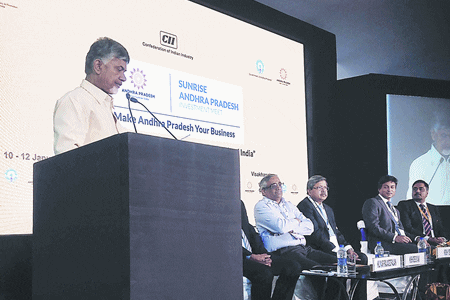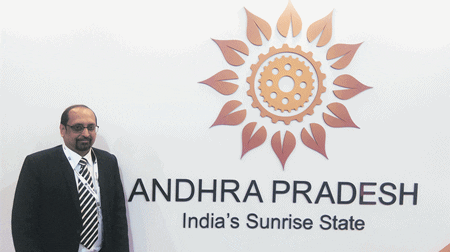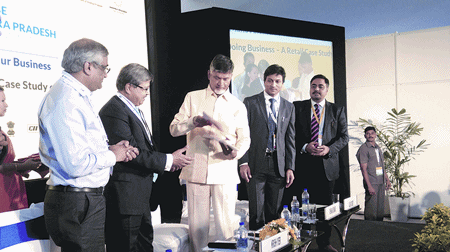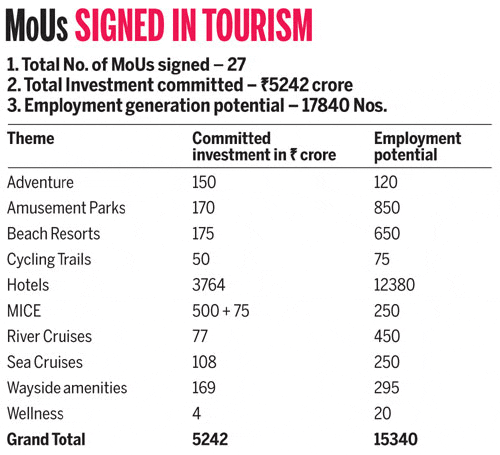Transformational tourism
N Chandrababu Naidu, chief minister of Andhra Pradesh, clearly defined the tourism road map at the recently held CII Partnership Summit in Visakhapatnam. From infrastructure to skill development, the state has promised to roll-out realtime projects in record time By Reema Lokesh
India’s newly bifurcated state is raring to go. The recently held CII Partnership Summit, spelt out the vision of the state’s chief minister, N Chandrababu Naidu, in clear terms. From agriculture to IT development, from telecom to tourism, from food processing to healthcare, the state has laid the tracks for a series of projects across industries. However, what was interesting to note at the event was Naidu’s vision for the tourism sector, as tourism seldom gets its share of priority when placed on a broader canvas. Naidu addressed the tourism session tilted, ‘Tourism in Andhra Pradesh – An Economic Change Agent’, wherein he spoke about the state’s commitment to bring in transformational tourism. “I am clear that in the near future Andhra Pradesh will be recognised as a world class tourism destination and we are committed to fulfill this vision. Inclusive development is the key and my team is here to provide the right environment for business. The work force of Andhra Pradesh is proactive and skilled. The state is blessed with tourism specialities such as beaches, summer resorts, hill stations, culture, heritage and more and the state is a prosperous ground for investment. I have to think of doing work innovatively and not traditionally. I firmly believe in resolving issues by talking and my state is committed to deliver.”
High profile delegates both from India’s public and private sector were present at the recently held CII Partnership Summit in Visakhapatnam. Like most investment summits, the state has promised single window clearance for projects, but has chosen to speak the language of inclusive growth and welfare for the masses. Naidu clearly stated that he made a mistake in his past tenure and was probably moving too ahead of his time. He was candid to agree that though the trickle down effect of development does have merit, however, welfare development is what truly works.
Andhra Pradesh aims to be among the top three states in India by 2022 and a developed state by 2029. With the second longest coastline of 974 kms in the country, a rich historical and cultural heritage, ancient and spiritual temples, serene valleys and hills, the new state of Andhra Pradesh with 13 districts holds vast tourist potential.
Tourism talk
The tourism panel had industry thought leaders speaking about the way forward for tourism in the state. Headed by the union minister for civil aviation, P Ashok Gajapathi Raju from the government sector, the private sector was represented by Nakul Anand, chairman, CII National Committee on Tourism and executive director, ITC; Manav Thadani, chairman, HVS Asia Pacific; Vivek Nair, chairman and managing director, The Leela Palaces, Hotels & Resorts; Sarajbit Singh, vice chairman, Federation of Associations in Indian Tourism & Hospitality (FAITH); Dr Subhash Chandra, chairman, Essel Group and ZEE; and investor S D Krishna Kumar. The union minister for civil aviation spoke about the future of aviation in Andhra Pradesh and how the state can compete on the ATF issue in terms of its pricing. Raju, spoke about the development of three modern airports in the state. He said that the state has gone through a painful rebirth but he is ready to move ahead stronger. He also highlighted the importance of the ‘Swachh Bharat’ mission and its benefit for the country in the long run and especially for the tourism sector. Anand shared a quick word on the importance of tourism and its universal benefits and how it has a positive impact on local communities and the society at large. He also spoke about the progressive approach of the state government towards development and also its commitment to build eco tourism assets in the state, provide a toll free number for tourists and providing electricity to the hospitality sector at industrial rates.
Dr Chandra, was strong in his views on the tourism sector and how this sector needs an orbit shift in its working and functioning. He also highlighted the need for tourism to be given infrastructure status.
Nair emphasised on the possibilities and opportunities in the area of coastal tourism and resort development. He spoke about the coastal regulation zone from sea and from cliff tops and edges. Sea planes are also a worthy tourism product that can be introduced, he further added. Thadani shared with the delegates the need to have more hotel rooms across categories and spoke about building a destination through hospitality investments. Singh spoke about the need for water sports facilities as a tourism option, while Kumar, spoke about how he took the risk and went ahead with his plan to set up tourism infrastructure in the state. Neerabh Prasad, principal secretary, tourism, Government of Andhra Pradesh, said that the state is ready to work as a catalyst for tourism growth. They expect the private sector to take up the development of tourism in the state as he firmly believes that it is best for the government to provide support rather than run tourism establishments.
Tourism policy statement
In 2013, 152.1 million domestic tourists visited Andhra Pradesh, which was about 13.3 per cent of the total domestic tourism market. The state offers nine major tourism themes:
- Beach and water-based
- Eco tourism
- Buddhism
- Religious
- Heritage
- Meetings, Incentives, Conferences, and Exhibitions (MICE) and infastructure development
- Recreation/ Adventure
- Spiritual/ Wellness
- Medical
These nine major themes are further categorised into 42 sub-themes.
Mission-based approach to developing tourism
The Government of Andhra Pradesh (GoAP) has envisaged a mission-based approach to firmly set Andhra Pradesh on the path of sustainable development and growth. Seven missions have been identified to provide support in managing externalities and enhance inter-departmental synergy for improving outcomes and reducing delays. The Service Sector Mission would focus on enhancing job opportunities and providing further fillip to sectors such as tourism, construction, hospitality, financial services, education, IT and other allied activities. The tourism sub-mission will work under the ambit of the Service Sector Mission. The tourism sub-mission will primarily focus on two key aspects:
- Theme-based development: It will focus on developing tourism projects under themes of beach and water-based, eco tourism, Buddhism, religious, heritage, MICE and infrastructure development, recreation/ adventure, spiritual/ wellness and medical.
- Destination-based development through Hub & Spoke model: It will focus on developing tourism circuits on a Hub & Spoke model. The emphasis will be on developing five important tourism hubs (Visakhapatnam, Vijayawada, Tirupati, Rajahmundry-Kakinada and Srisailam-Nagarjuna Sagar) by 2020, and all other district headquarters as tourism hubs by 2029. Through this policy, GoAP endeavours to make the state more conducive and attractive for potential investors and provide an impetus to the tourism sector.
Policy targets
In line with the objectives, the following targets have been set:
- To be the most preferred state in India for domestic tourist arrivals and among top 12 states for international tourist arrivals.
- To facilitate investments in the tourism sector to the tune Rs 10,000 crore and contribute seven per cent to the state GDP by 2020.
- To facilitate creation of five lakh additional jobs in the tourism sector.
The policy will be valid from the date of notification till March 31, 2020.







